 Moon Occultation Of Mars (Updated Dec. 7, 2022)
Moon Occultation Of Mars (Updated Dec. 7, 2022)
 Moon Occultation Of Mars (Updated Dec. 7, 2022)
Moon Occultation Of Mars (Updated Dec. 7, 2022)
C2014-Q2
|
Moon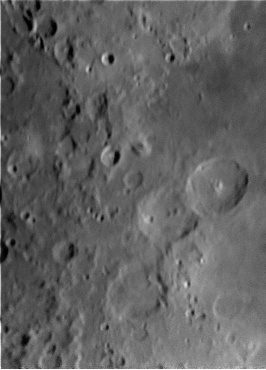
|
Moon
|
|
Designation: C2014-Q2 Alternate Name: Comet Lovejoy Constellation: Taurus Imaging Date: January 10, 2015 Imaging Location: Concord M Exposure Time: 25 frames@20sec ~ 8.3min Gain Setting: ISO 400 Imaging Device: Canon Rebel T3i Optics: LX200R 10" SCT Focal Reducer: Optec Lepus 0.62X Filter: none Comment: My second comet...nice emerald green color. I managed to catch some of its tail in both the medium and high mag view. |
Object: Moon Description: Theophilus Crater Region Imaging Date: July 18, 2010 Imaging Location: Concord M No. of Stacked Frames: 284 Imaging Device: Logitech 9000 Webcam Optics: LX200R 10" SCT Optical Train: Prime Focus Comment: I have been strangely drawn to this part of the Moon for decades now. I even have a B&W photo I took of this same region (coincidentally) using a film camera on my old Edmund 8 inch f/5 scope about three decades ago! I finally realize why that is...near the center of this photo is the crater Kant, the namesake for my website and a tribute to perhaps THE most enlightened individual on this planet. Interestingly, the location for the Apollo 16 landing site is near the left edge of this photo as well. |
Object: Moon Description: Mare Fecunditatis and Lagrenus Crater Imaging Date: October 23, 2010 Imaging Location: North Bridge M No. of Stacked Frames: 38 Imaging Device: Logitech 9000 Webcam Optics: LX200R 10" SCT Optical Train: Prime Focus Comment: |
Mars-with-Yellow-Filter
|
Mars
|
Mars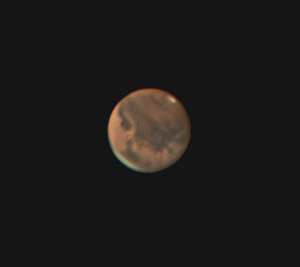
|
|
Object: Mars-with-Yellow-Filter Description: Just fter Opposition Imaging Date: August 7, 2018 Imaging Location: Concord M No. of Stacked Frames: 8653 Imaging Device: Skyris 132c Optics: LX200R 10" SCT Optical Train: Powermate2.5X Comment: Mars using a yellow filter. |
Object: Mars Description: Just Past Opposition Imaging Date: December 5, 2022 Imaging Location: Concord M No. of Stacked Frames: 6027 Imaging Device: ZWO ASI385 Optics: Classic LX200 12" SCT Optical Train: Powermate2.5X Comment: First time use of an ADC! I think for serious planetary work, this is a necessity. I didn't get a chance to use it for Saturn this year, but I can definitely see its benefits. |
Object: Mars Description: Just Past Opposition Imaging Date: October 31, 2020 Imaging Location: Concord M No. of Stacked Frames: 4836 Imaging Device: ZWO ASI385 Optics: Classic LX200 12" SCT Optical Train: Powermate2.5X Comment: The next time Mars will be this close and so well positioned in the sky, it will be 2052 and I'll be an old man! This image was taken with Mars at an equatorial diameter of just a shade over 20", 2.5" less than at it's closest approach of 38.6 million miles on Oct. 6. What can I say? the weather just wouldn't cooperate. Nevertheless, I have some nice detail, with the south pole on the top, and high altitude clouds on the bottom. I can add this to my collection of previous Mars opposition images. Here's a great schematic showing recent oppositions and the next one 26 months from now. |
Jupiter-and-Saturn-Conjunction
|
Mars-87PercentIlluminated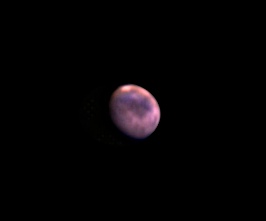
|
Venus
|
|
Designation: Jupiter-and-Saturn-Conjunction Alternate Name: 6 arc min sep at 4 24EST Constellation: Capricorn Imaging Date: December 21, 2020 Imaging Location: Concord M Exposure Time: 1 frame@49msec ~ 0.049sec Gain Setting: 0 Imaging Device: ZWO ASI2600 Optics: Classic LX200 12" SCT Focal Reducer: Meade Series 4000 f/6.3 Filter: none Comment: I really didn't think the weather would cooperate, so I didn't really prepare for this. But this is the beauty of having a semi-permananent mount with a beautifully aligned scope...everything was ready to go within minutes. The clouds cleared and I ran out to uncover my scope. I hadn't even tried out my ASI2600mc for planetary imaging yet, but the standard ZWO capture program let me get it up and running just in time to catch some spectacular photos of this 1-in-800 year event. This image is what you would have seen had you looked through my 12 inch scope at 4:24PM EST on the day of the solstice. The images here (a stacked version) and here (a magnified, more focused version) are better, but I liked the spontaneity of this one - not completely in focus, but wondrous in the realness of the event - even the great Red Spot made an appearance. Now how spectacular is that? So big deal you might say...a part of me thought the same initially...the event has no significance physically - just a meaningless superposition of two planets we see all the time. But then I thought...think of how beautiful these two planets are...the largest planet in our solar system, with colored bands and a 400 year old raging red storm - the other, a gas giant planet with almost fake looking (but real!) rings of ice and rock - both in the same field of view for human eyes to witness in a moment in time that won't come again for almost a thousand years. You're alive now in just the right time in history with technology sufficiently advanced for you to get to see it. That's something isn't it? |
Object: Mars-87PercentIlluminated Description: Dark Blue Filter Imaging Date: October 14, 2018 Imaging Location: Concord M No. of Stacked Frames: 21763 Imaging Device: ZWO ASI385 Optics: LX200R 10" SCT Optical Train: Powermate2.5X Comment: Here is Mars using a dark blue filter again but this time using my new ZWO ASI385 camera. Mars is only half the size it was during opposition. Odd thing is the color of Mars using this filter was much more "normal" with my Skyris camera...not sure why that would be the case. South is at the top, and east is to the left. Notice the phase of Mars is completely obvious here, with Mars only 87% illuminated. |
Object: Venus Description: First Time Capture Imaging Date: September 3, 2018 Imaging Location: Concord M No. of Stacked Frames: 1908 Imaging Device: Skyris 132c Optics: LX200R 10" SCT Optical Train: Powermate2.5X Comment: This is the first time I've tried imaging Venus by itself...interesting range of colors, but no detail of course. |
Jupiter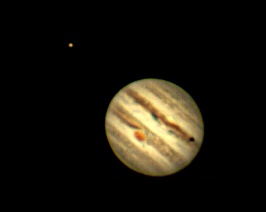
|
Mars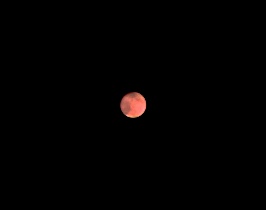
|
Jupiter
|
|
Object: Jupiter Description: Europa Transit Imaging Date: April 15, 2016 Imaging Location: Concord M No. of Stacked Frames: 4700 Imaging Device: Skyris 132c Optics: LX200R 10" SCT Optical Train: Powermate2.5X Comment: Back to Jupiter with this shot of a Europa moon and shadow transit! See the GIF here. |
Object: Mars Description: Near Opposition Imaging Date: April 2, 2012 Imaging Location: Concord M No. of Stacked Frames: 1080 Imaging Device: Logitech 9000 Webcam Optics: LX200R 10" SCT Optical Train: Prime Focus Comment: Some beautiful subtle detail visible in this image. This must be one of the clearest shots of Mars I've gotten so far. |
Object: Jupiter Description: Ganymede and Io Imaging Date: September 10, 2022 Imaging Location: Concord M No. of Stacked Frames: 3866 Imaging Device: ZWO ASI385 Optics: Classic LX200 12" SCT Optical Train: Powermate2.5X Comment: |
Uranus
|
Jupiter
|
C2011-L4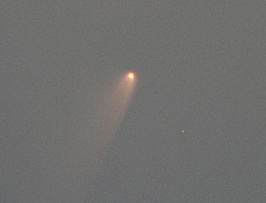
|
|
Object: Uranus Description: Conjunction with 44 Piscium Imaging Date: September 23, 2012 Imaging Location: Concord M No. of Stacked Frames: 1 Imaging Device: Logitech 9000 Webcam Optics: LX200R 10" SCT Optical Train: Prime Focus Comment: This was my first attempt at Neptune's twin planet Uranus!...Only about 1.4' from 44 Piscium on September 23, 2012! It looked like a beautiful multi-color double star. We showed this view at a public star night put on by the Skylight Astronomical Society of Stow, MA - it was a fantastic opportunity to challenge observers to actually see the difference between a planet and a star. Click here for a 30 sec clip of the live view! |
Object: Jupiter Description: Great Red Spot and Europa Imaging Date: November 19, 2012 Imaging Location: Concord M No. of Stacked Frames: 1006 Imaging Device: Logitech 9000 Webcam Optics: LX200R 10" SCT Optical Train: Prime Focus Comment: Jupiter and Europa - one of my best images of Jupiter yet. The conditions that night were exceptionally clear and rock steady (for Concord) and I was able to get some nice crisp images. You can see the small red spot, the Great Red Spot and a swirling white storm just above it, as well as several dark disturbances on the upper belt. If you click here, a small WMV should pop up, consisting of six frames generated from over 5000 images. |
Designation: C2011-L4 Alternate Name: Comet Panstarrs Constellation: Andromeda Imaging Date: March 13, 2013 Imaging Location: Harvard M Exposure Time: 1 frames@3sec ~ 0.1min Gain Setting: ISO 800 Imaging Device: Canon Rebel T3i Optics: 300mm Telephoto Focal Reducer: NA Filter: none Comment: Nice catch just after sunset! My first comet picture ever. |
Mars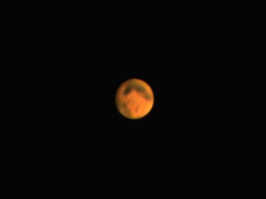
|
Jupiter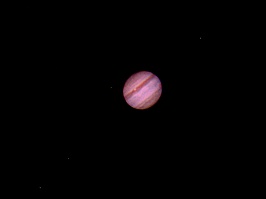
|
Mars
|
|
Object: Mars Description: Month After Opposition Imaging Date: June 24, 2016 Imaging Location: Concord M No. of Stacked Frames: 4354 Imaging Device: Skyris 132c Optics: LX200R 10" SCT Optical Train: Powermate2.5X Comment: A month after opposition and Mars is still looking good! I was able to get quite a few decent images of Mars this time around, although the polar caps have been somewhat elusive. |
Object: Jupiter Description: White Spot Imaging Date: October 9, 2010 Imaging Location: Orleans M No. of Stacked Frames: 1781 Imaging Device: Logitech 9000 Webcam Optics: LX200R 10" SCT Optical Train: Prime Focus Comment: The conditions in Orleans that night were really good. You can see the four Galilean moons, a white spot and half of the Red Spot, including some beautiful band structure. |
Object: Mars Description: Near Opposition Imaging Date: May 12, 2016 Imaging Location: Concord M No. of Stacked Frames: 4641 Imaging Device: Skyris 132c Optics: LX200R 10" SCT Optical Train: Powermate2.5X Comment: Here's my first picture of Mars since I started working with the Skyris. Seeing was horrible, but I still managed to get some detail from the red planet. If you click here, you can compare my image with a labeled picture taken by Phil Miles with his 20 inch scope around the same time as mine. The main structures on Mars came out quite nicely despite my poor conditions. What I thought was an artifact of my processing also turned out to be clouds at the south pole! I often go by Registax's call on quality and sometimes even hand pick planetary images. However, this time, Registax indicated that all but about 100 images were any good, so I decided to use all of them. Shows you the power of image stacking! |
Saturn
|
Jupiter
|
Mars
|
|
Object: Saturn Description: At Opposition Imaging Date: June 24, 2016 Imaging Location: Concord M No. of Stacked Frames: 2815 Imaging Device: Skyris 132c Optics: LX200R 10" SCT Optical Train: Powermate2.5X Comment: My best image of Saturn yet! I could always get Cassini's division to the left and right of Saturn, but imaging it in front and back was always a challenge...you can just barely make it out in this image! You can also clearly see a major cloud band around Saturn's equator and a fainter one higher up. To get this image, I stacked over 2800 images extracted from a video taken at exactly midnight the morning of June 24, 2016, only three weeks after opposition, using my Skyris camera and powermate. Saturn's low altitude also resulted in significant atmospheric dispersion causing the rings to appear bluer on top and redder on the bottom. |
Object: Jupiter Description: Double Moon Transit Imaging Date: October 23, 2010 Imaging Location: North Bridge M No. of Stacked Frames: 124 Imaging Device: Logitech 9000 Webcam Optics: LX200R 10" SCT Optical Train: Prime Focus Comment: One of my first small wmvs for a double moon transit is shown here. You can see both moon shadows clearly, with Ganymede casting the upper right shadow and Europa casting the lower left. I remember the first time I ever saw a moon transit across Jupiter's surface. I was only 16 years old and likely only one of a handful of individuals on the planet witnessing the event. Realizing you're watching the shadow of a real object moving across the surface of another planet over 400 million miles away is a humbling experience - making you truly appreciate the physical reality of the Universe. |
Object: Mars Description: Near Opposition Imaging Date: March 20, 2012 Imaging Location: Concord M No. of Stacked Frames: 1672 Imaging Device: Logitech 9000 Webcam Optics: LX200R 10" SCT Optical Train: Prime Focus Comment: I took this right after fixing my loose secondary mirror and corrector. I then collimated the scope and got this wonderfully clear image of Mars. Unfortunately there were no significant marks at the time, but you can definitely see the clarity of the image! Check out these before and after images here |
Comet-C2020-F3
|
Comet-46P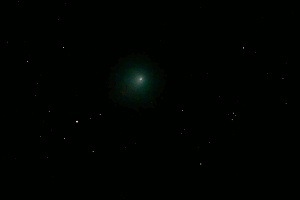
|
Venus-and-Jupiter
|
|
Designation: Comet-C2020-F3 Alternate Name: Comet Neowise 2 Constellation: Auriga Imaging Date: July 15, 2020 Imaging Location: Concord M Exposure Time: 1 frames@10sec ~ 0.2min Gain Setting: ISO 1600 Imaging Device: Canon Rebel T3i Optics: 200mm Telephoto Focal Reducer: NA Filter: none Comment: Funny how comets that are often predicted to be spectacular end up being duds, while others, like Neowise appear suddenly and surprise us. This comet was discovered by the Wide-field Infrared Survey Explorer (WISE) space telescope in March 2020 and is the brightest comet seen in the northern hemisphere since Hale-Bop in 1997. I was surprised to be able to see its tail visually quite easily. I took this about an hour after the sun set on July 15, 2020 using my DSLR with a 200mm lens on a tripod and a 10sec exposure using an ISO setting of 1600. Here's another picture of it. |
Designation: Comet-46P Alternate Name: Comet Wirtanen Constellation: Eridanus Imaging Date: December 7, 2018 Imaging Location: Madison CT Exposure Time: 50 frames@20sec ~ 16.7min Gain Setting: ISO 6400 Imaging Device: Canon Rebel T3i Optics: LX200R 10" SCT Focal Reducer: Optec Lepus 0.62X Filter: none Comment: Still at only magnitude 6.0, Comet Wirtanen should hopefully be brightening as it gets closer to the Sun. This GIF shows the traversal of the comet against the background star field in Eridanus over a period of about 25 minutes. The field is about 30' x 20'. |
Designation: Venus-and-Jupiter Alternate Name: Venus and Jupiter Conjunction Constellation: Leo Imaging Date: June 30, 2015 Imaging Location: Concord M Exposure Time: 1 frame@3msec ~ 0.003sec Gain Setting: ISO 400 Imaging Device: Canon Rebel T3i Optics: LX200R 10" SCT Focal Reducer: Optec Lepus 0.62X Filter: none Comment: I got lucky with this shot! Just as the clouds came rolling in, I managed to take this image of both Venus and Jupiter a mere third of a degree apart on June 30, 2015! Of course, Jupiter had to be enhanced separately, but with a little work, the composite came out great! If you look closely, you can see several bands on the planet, including a small reddish smudge, which of course, is the red spot! - I verified it wasn't an artifact of the processing by looking up the transit time of the Red spot - right where it was supposed to be! Pretty amazing considering the magnification and the resolution of the image! This image also shows that it *is* possible to get a reasonable image of both Venus and Jupiter in the same frame using a single exposure time (in this case 1/400s and ISO400), provided you can enhance Jupiter sufficiently. Regarding the image processing: Jupiter was taken from another frame with the same exposure time but only about 30 seconds after the first Venus/Jupiter image was. The Jupiter region in the second image was enhanced, then cut out and pasted over top of the Jupiter in the first Venus/Jupiter image, then blended around the edges to improve its appearance. Absolutely, creative license, and maybe too much, but representative of the reality at the time, and the end result was a quite pleasing, capturing the moment as I saw it. To me, that's what much of this is all about - preserving memories and capturing the Universe's best moments! |
|
Go toTop of Page |
Last Updated: Dec. 28, 2022 |
Back to Home Page. |